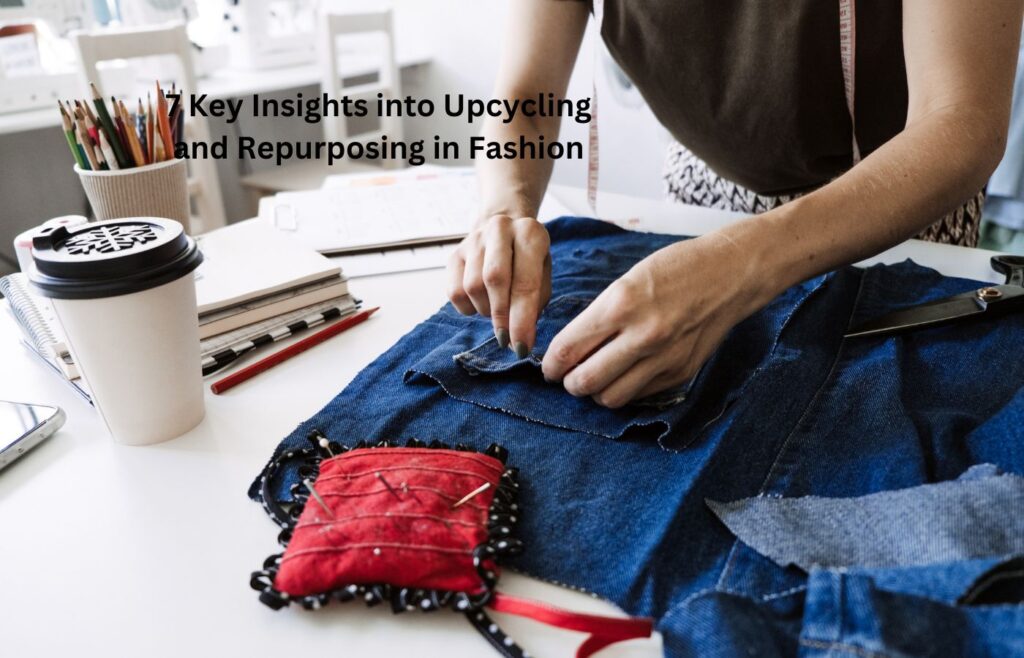Introduction – Upcycling and Repurposing in Fashion
In response to increased customer demand for ethical standards and environmental concerns, the fashion industry is undergoing a fundamental change towards sustainability.
With its high waste output and negative effects on the environment, the traditional fast fashion model is being abandoned in favor of this change.
Eco-friendly production techniques, ethical sourcing, and the advancement of circular economy ideas are all highlighted by sustainable fashion.
Within this movement, upcycling and repurposing in fashion have become big trends that are changing the face of fashion. recycling is the process of giving used clothing a new lease on life by combining or altering it, whereas upcycling is imaginatively recycling materials or clothing to create new goods of greater quality or value.
These methods of upcycling and repurposing in fashion not only cut down on waste but also show off fashion design’s capacity for originality and ingenuity.
Upcycling and repurposing in fashion provide appealing alternatives to traditional fashion consumption as customers place a higher value on sustainability and originality when making purchases.
In this post, we’ll look at the business prospects these trends bring and how upcycling and repurposing in fashion may be used by entrepreneurs to launch profitable, eco-friendly fashion businesses.
Understanding Upcycling and Repurposing in Fashion

Upcycling, as used in fashion, is the practice of repurposing unused materials to create new, higher-quality, or more valuable accessories or clothing. This method entails prolonging the life of items that would otherwise wind up in landfills while reducing waste.
Repurposing, on the other hand, is giving worn-out clothing a new lease on life by inventively altering or combining it with other items to create novel and distinctive pieces with a revitalized appeal.
It is impossible to overestimate the significance of upcycling and repurposing in the fashion industry, especially when it comes to cutting down on fashion waste. The fashion sector is well-known for producing a great deal of waste, with a large quantity of textiles ending up in landfills every year.
Upcycling and repurposing in fashion materials offer sustainable solutions by keeping them out of the trash and using them in new designs, which greatly lessens the environmental effect of the fashion industry.
Upcycling has been effectively incorporated into the business structures of numerous fashion designers and corporations. For example, “Reformation” reduces waste and promotes sustainable practices by creating new collections from vintage apparel and deadstock textiles.
“Patagonia,” which is well-known for its Worn Wear initiative, which encourages customers to fix and upcycle their clothing, is another noteworthy example. Another well-known example is “Patagonia,” which is well-known for its Worn Wear initiative, which encourages users to fix and repurpose their clothing to highlight the durability and adaptability of recycled apparel.
Furthermore, companies like “Eileen Fisher” and “Stella McCartney” have included repurposed materials in their designs, showing how luxury fashion can adopt eco-friendly methods.
These illustrations show how upcycling and repurposing in fashion has revolutionized the fashion business by encouraging creativity, cutting waste, and advocating for a more environmentally friendly method of producing and consuming apparel.
Consumer Trends Driving Upcycling and Repurposing in Fashion
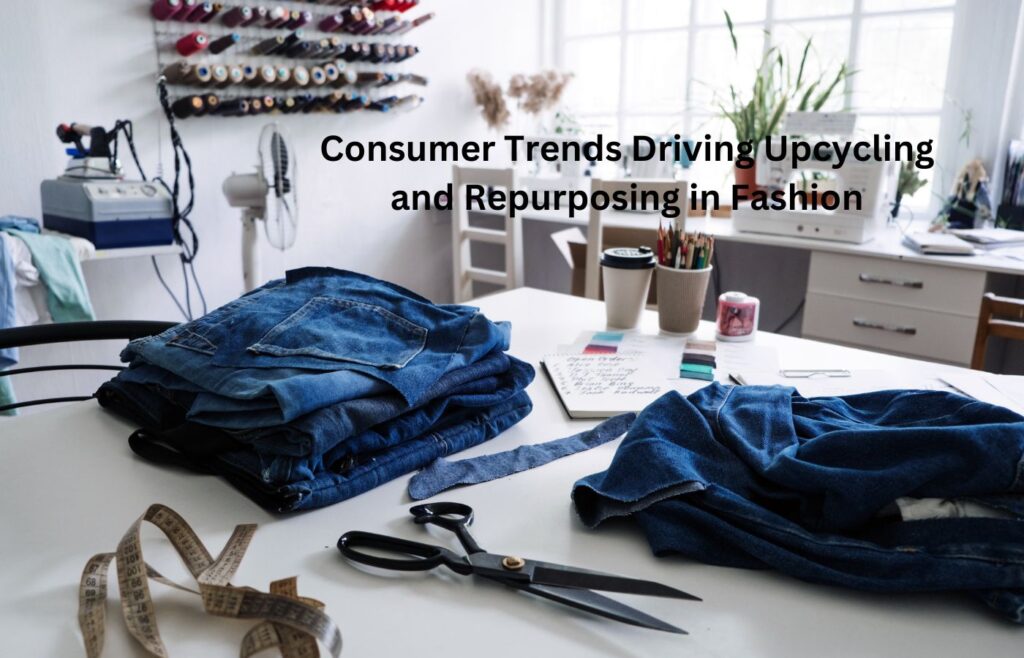
Recent years have seen a sharp increase in consumer awareness of environmental challenges in fashion, which has increased demand for sustainable fashion approaches including upcycling and repurposing.
People are actively looking for alternatives that are consistent with their values as they become more aware of the detrimental effects fast fashion has on the environment.
Customers are choosing brands and goods that emphasize sustainability as a result of this increased awareness, which has led to a shift in consumer behavior towards more environmentally friendly practices.
Concerns about the environment are not the only things driving customer demand for customized and distinctive apparel. Fashion pieces that have been upcycled or recycled have a unique appeal since they are unique pieces with a backstory.
Because of their quest for uniqueness and self-expression, buyers look for upcycled designs that distinguish themselves from mass-produced clothing, which adds to the popularity of these practices.
It is impossible to overstate the importance that social media and influencers have on the promotion of sustainable fashion, which includes upcycling and repurposing in fashion. Consumer behavior is greatly influenced by influencers who promote eco-friendly lives and display recycled fashion on social media sites like Instagram and TikTok.
Their support of environmentally friendly companies and activities raises awareness and motivates their followers to buy more sustainably. Social media platforms also help upcycling and repurposing in fashion firms become more visible, which expands their audience and helps them create communities around sustainable fashion techniques.
All things considered, these consumer trends highlight a fundamental change in the fashion industry towards more conscientious and ecological purchase behaviors. Upcycling and repurposing in fashion are not only responses to environmental challenges but also reflections of changing consumer preferences for unique, eco-friendly, and socially responsible fashion options.
Business Opportunities in Upcycling and Repurposing in Fashion
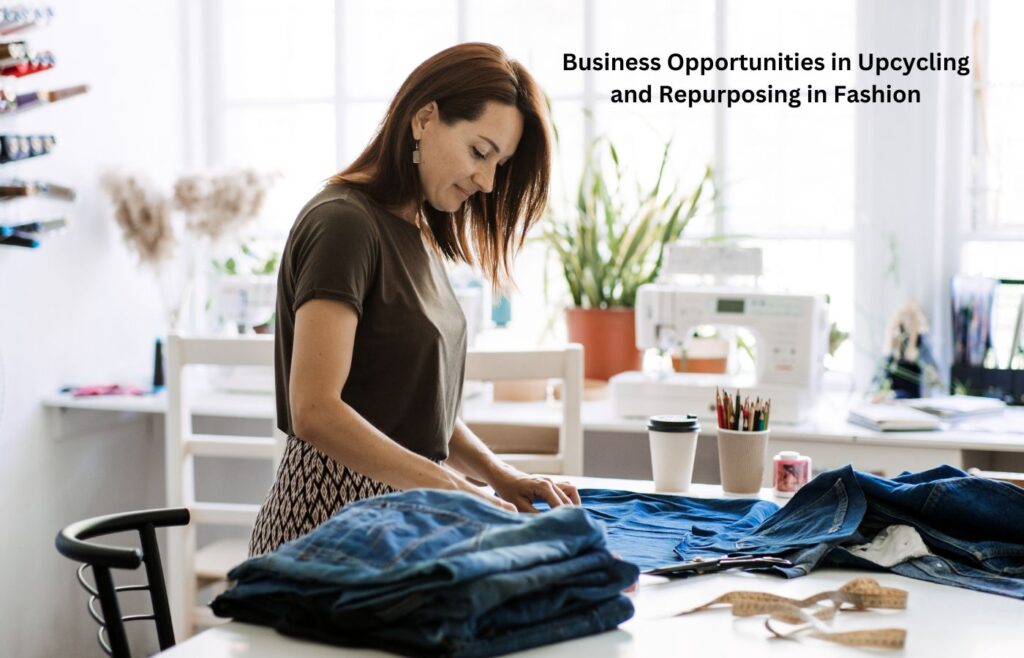
Many creative business models related to upcycling and repurposing in fashion have surfaced, providing chances for entrepreneurs to prosper in the sustainable fashion industry. Upcycled clothing firms focus on distinctive designs and craftsmanship that appeal to eco-conscious clients looking for one-of-a-kind pieces.
They specialize in creating new outfits from discarded materials like fabric scraps or pre-loved clothing. Repurposing antique goods is another profitable business venture. Here, entrepreneurs turn worn-out or damaged apparel into stylish, modern pieces that appeal to nostalgia and support environmentally friendly business methods.
Partnerships with designers and artists are also essential for promoting innovation and visibility in the upcycling sector. Upcycling companies can create inventive collections with repurposed materials by collaborating with creative people, drawing in a wider clientele interested in distinctive and creative clothing.
Furthermore, providing do-it-yourself (DIY) kits and workshops gives customers the resources, direction, and instruments they need to make their own repurposed clothing. These programs attract people looking for customized and eco-friendly substitutes for traditional apparel consumption since they not only encourage creative expression via hands-on activities but also encourage community involvement around sustainable fashion practices.
Each of these company concepts serves a rising market of customers that prioritize sustainability and creativity in their fashion choices, demonstrating the potential for entrepreneurship in the upcycling and repurposing in fashion arena.
Steps to Launch an Upcycling and Repurposing in Fashion Business
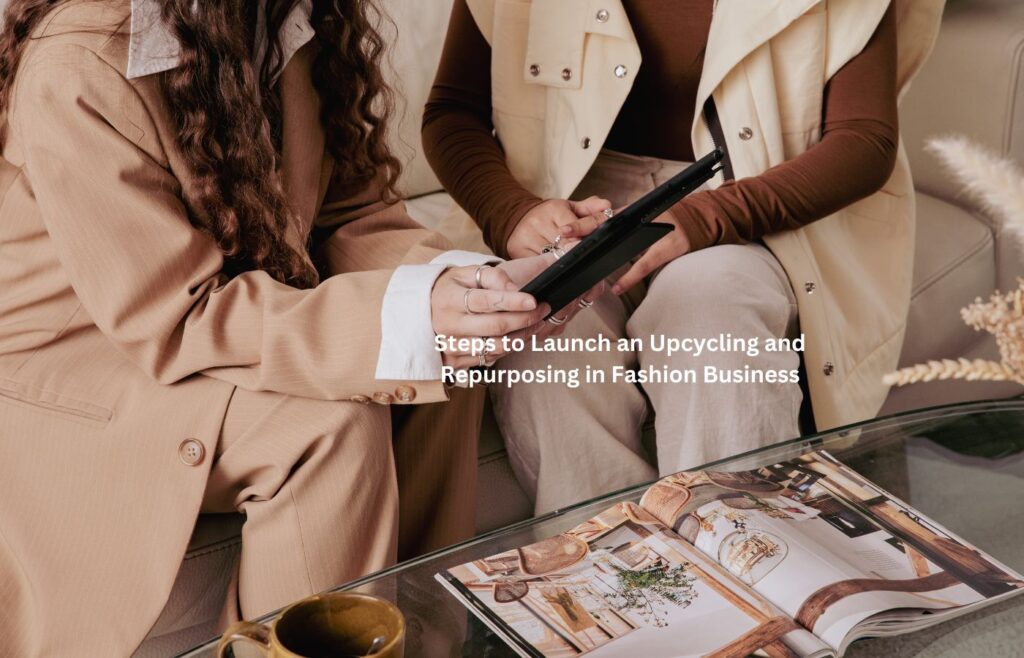
Starting a business selling recycled clothing involves meticulous preparation and execution of several crucial tasks. To determine the target audience and comprehend customer preferences, the first step entails carrying out extensive market research.
This involves assessing consumer interest in eco-friendly clothing and figuring out how much the market will bear in repurposed goods.
Subsequently, acquiring materials responsibly is necessary to uphold the company’s environmentally conscious culture. This entails finding vendors of waste materials, including textile waste or used apparel, and forming alliances that support the brand’s environmental objectives.
In an upcycled fashion firm, innovation and high-quality workmanship should be given priority in the design and production processes. To create distinctive and appealing fashion pieces that can be both durable and aesthetically pleasing, designers need to go beyond the box.
Strategies for pricing upcycled goods should take into account the workmanship and sustainability value proposition. Because of its distinctiveness and eco-friendliness, upcycled clothing frequently commands premium prices; yet, it’s important to find a balance that appeals to the target market without sacrificing profitability.
Entrepreneurs may successfully start and grow an upcycled fashion business that appeals to eco-conscious customers and advances the sustainable fashion movement by carefully adhering to these guidelines.
Challenges and Solutions – Upcycling and Repurposing in Fashion
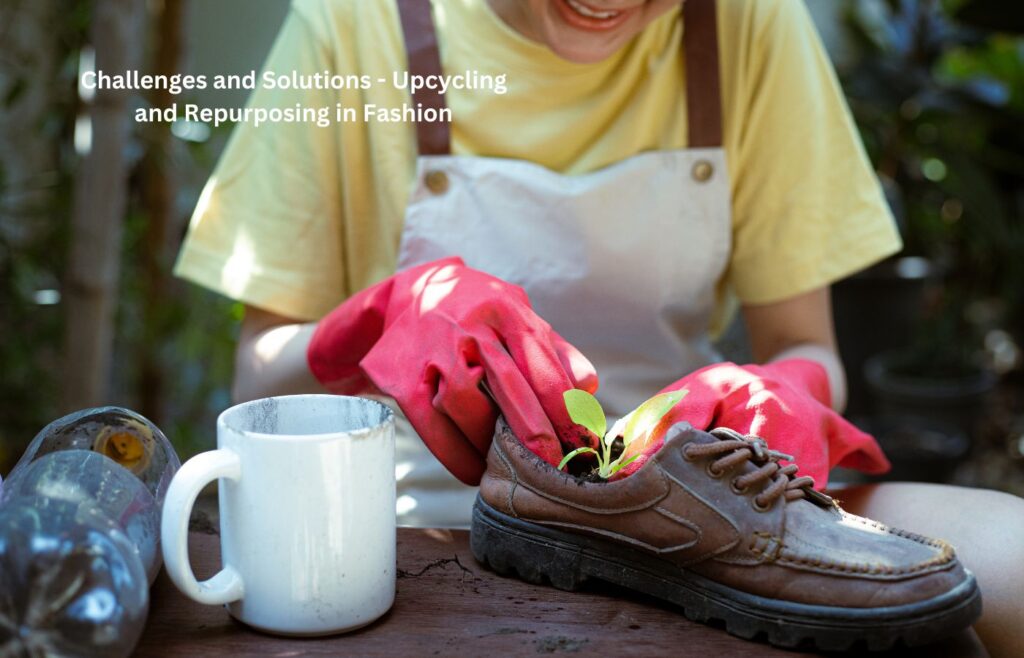
There are obstacles to face when starting and running an upcycled fashion business, but they are not insurmountable. Finding high-quality materials for upcycling and repurposing in fashion is a major obstacle. It can be difficult to find a reliable source of old or abandoned materials that are up to par.
To solve this, companies might form alliances with vendors, recycling centers, or secondhand shops to get a consistent supply of materials and make sure they meet sustainability standards.
Another challenge is scaling up production while keeping sustainability. Businesses need to figure out how to boost output without sacrificing environmentally responsible methods as demand rises.
To reduce carbon footprint, some solutions are to invest in energy-efficient machinery, prioritize local sourcing, and optimize production processes.
Market acceptance of repurposed apparel depends on educating consumers about its benefits. Many customers may be unaware of the advantages of repurposed goods.
Enterprises can tackle this obstacle by executing comprehensive marketing and instructional initiatives that emphasize the ecological advantages, distinctiveness, and excellence of used clothing. relationships with proponents of sustainable fashion and influencer relationships can also aid in increasing awareness and improving the market’s view of upcycled goods.
Upcycled fashion companies may successfully traverse the industry’s difficulties while promoting sustainability and encouraging consumer adoption of eco-friendly fashion options by proactively addressing these issues with calculated solutions.
Case Studies and Success Stories – Upcycling and Repurposing in Fashion
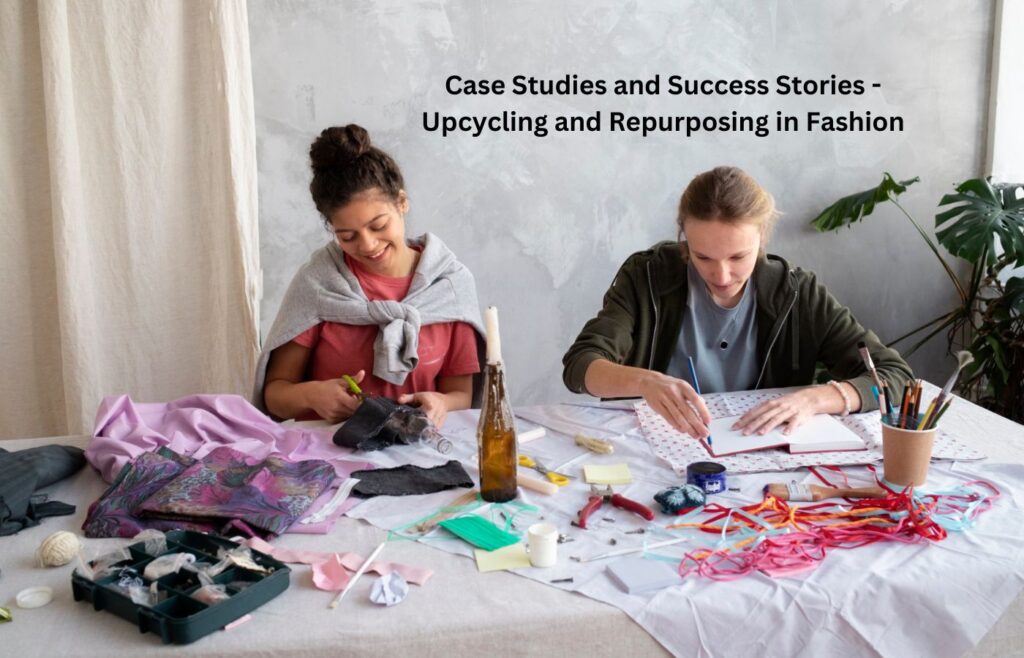
Upon examining prosperous upcycled fashion brands, a few noteworthy instances emerge within the sector. One such company is “Reformation,” which is renowned for its dedication to using recycled materials and environmental processes.
Reformation upcycles vintage apparel and deadstock textiles to produce fashionable clothing lines that are also eco-friendly. Reformation’s use of upcycling as a primary business model has decreased waste and drawn in a devoted clientele of people looking for eco-friendly fashion substitutes.
“Patagonia,” a well-known outdoor clothing company that uses recycled materials in its goods, is another noteworthy case study. Through its Worn Wear program, Patagonia encourages customers to fix and repurpose their clothes, showcasing the durability and adaptability of recycled gear.
Patagonia has shown through programs like these how important circular economy ideas are for minimizing environmental impact while maintaining brand integrity.
Aspiring upcycled fashion entrepreneurs can learn a lot from these success tales. The significance of openness and sincerity in sustainability initiatives, cultivating a powerful brand identity in line with environmentally conscious principles, and giving innovation a top priority in the design and production processes are some important lessons learned.
Furthermore, to highlight the value of recycled items, successful upcycled fashion firms stress the need for community engagement and client education.
Aspiring upcycled fashion entrepreneurs can gain knowledge and inspiration to create successful business plans that connect with customers and advance the sustainable fashion movement by reading these case studies and learning from their experiences.
Future Trends and Innovations – Upcycling and Repurposing in Fashion
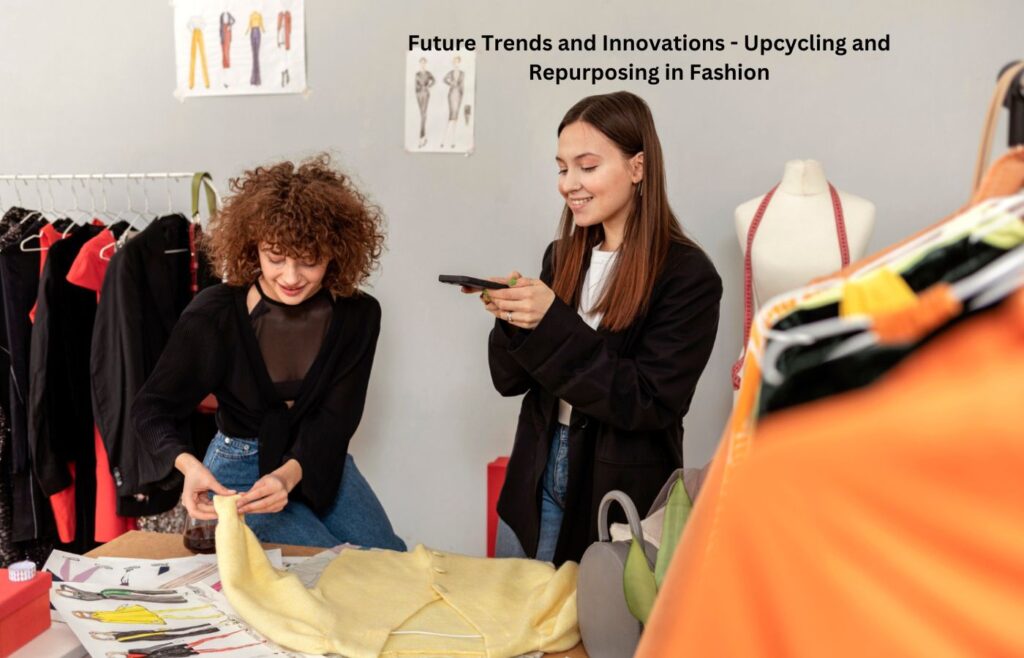
In the future, technology has the potential to revolutionize upcycling techniques in the fashion sector. Artificial intelligence (AI) and machine learning are two innovations that can improve material sorting and identification, making textile waste recycling more accurate and efficient.
Automation technologies also hold promise for optimizing upcycling procedures, lowering labor expenses, and boosting production scalability all the while upholding sustainability and quality standards.
In addition, adopting circular economy models—where materials are continuously recycled and repurposed to minimize waste and environmental impact—will be key to the future of fashion. Upcycling is essential to this paradigm change since it prolongs the life of fabrics and lessens the need for virgin resources.
By adopting circular economy principles, fashion brands can create closed-loop systems that prioritize resource efficiency and sustainability throughout the product lifecycle.
Cutting-edge business concepts that promote a more circular approach to fashion consumption are increasingly gaining popularity, such as platforms for renting and reselling items. By encouraging clothes reuse and circulation, these platforms help to lessen the environmental impact of the apparel sector.
The fashion industry is expected to witness substantial breakthroughs in the integration of technology-driven upcycling processes and circular economy models as consumer awareness and demand for sustainable fashion continue to develop. This will pave the way for a future of fashion that is more resilient and sustainable.
Conclusion – Upcycling and Repurposing in Fashion
In conclusion, upcycling and repurposing in fashion offer creative answers to the environmental problems the fashion industry faces and special business chances for sustainability-minded businesspeople.
We’ve discovered some important details from our investigation that demonstrate the revolutionary potential of upcycled clothing:
First off, inventively recycling and upcycling waste materials into brand-new, appealing products, greatly help to reduce fashion waste. This strategy supports the transition to circular economy principles and is in line with customer desires for environmentally friendly options.
Second, many different approaches may be used in repurposed fashion business models, ranging from partnerships with designers and do-it-yourself workshops to niche upcycled apparel firms. These varied strategies enable business owners to use creativity and innovation in their endeavors while catering to various customer segments.
Well-considered solutions are needed for problems including finding high-quality materials, sustainably growing manufacturing, and enlightening customers about the benefits of repurposed clothing.
Successful upcycled fashion enterprises can be achieved by entrepreneurs through the implementation of thorough marketing strategies, the adoption of efficient production techniques, and strong relationship building.
Aspiring business owners see upcycling as a special chance to address the growing demand for sustainably and ethically manufactured apparel while also having a beneficial environmental impact.
Through the alignment of business objectives with sustainability, entrepreneurs may create a unique brand identity, draw in eco-aware customers, and foster a more conscientious fashion industry.
To sum up, repurposing and upcycling are more than just fashion fads; they symbolize a revolutionary movement towards environmentally conscientious buying.
By adopting upcycling, company owners may create lucrative enterprises and work as change agents in the fashion industry, ushering in a new era of creative and sustainable fashion methods.
How is upcycling different from recycling?
Upcycling focuses on creatively reusing materials to make new products without breaking them down entirely, while recycling involves breaking down materials to create new ones.
Why is upcycling important in fashion?
Upcycling reduces waste and minimizes the environmental impact of fashion by repurposing existing materials, promoting sustainability in the industry.
What are common materials used in upcycling fashion?
Common materials include denim from old jeans, vintage fabrics, discarded leather, and even plastic bottles transformed into textiles.
How can individuals start upcycling in fashion at home?
Start by repurposing old garments, experimenting with sewing techniques, or customizing existing clothing with patches or embellishments.
What are the benefits of upcycled fashion?
Upcycled fashion promotes uniqueness, reduces carbon footprint, supports ethical practices, and encourages creativity in design.
Where can I find upcycled fashion products?
Look for local artisan markets, and online platforms specializing sustainably, or explore DIY upcycling tutorials to create your unique pieces.
The article “The Rise of Upcycling and Repurposing in Fashion” is written by Farhanul Haque, Fashion Business Ideas. Our team of passionate writers and experts shares tips and inspiration on gardening, home improvement, and design to help you create your dream space.

